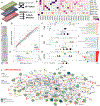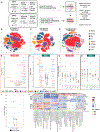Systems biology dissection of PTSD and MDD across brain regions, cell types, and blood
- PMID: 38781393
- PMCID: PMC11203158
- DOI: 10.1126/science.adh3707
Systems biology dissection of PTSD and MDD across brain regions, cell types, and blood
Abstract
The molecular pathology of stress-related disorders remains elusive. Our brain multiregion, multiomic study of posttraumatic stress disorder (PTSD) and major depressive disorder (MDD) included the central nucleus of the amygdala, hippocampal dentate gyrus, and medial prefrontal cortex (mPFC). Genes and exons within the mPFC carried most disease signals replicated across two independent cohorts. Pathways pointed to immune function, neuronal and synaptic regulation, and stress hormones. Multiomic factor and gene network analyses provided the underlying genomic structure. Single nucleus RNA sequencing in dorsolateral PFC revealed dysregulated (stress-related) signals in neuronal and non-neuronal cell types. Analyses of brain-blood intersections in >50,000 UK Biobank participants were conducted along with fine-mapping of the results of PTSD and MDD genome-wide association studies to distinguish risk from disease processes. Our data suggest shared and distinct molecular pathology in both disorders and propose potential therapeutic targets and biomarkers.
Conflict of interest statement
Within the past 2 years: N.P.D. is on the scientific advisory boards for BioVie Inc., Circular Genomics, Inc. and Feel Therapeutics, Inc. And for unrelated work; D.R.W. is on the advisory boards of Pasithea Therapeutics and Sage Therapeutics for unrelated work; D.D. is a cofounder of ARC Proteomics, and cofounder and paid consultant of Emtherapro Inc.; C-Y.C. is an employee of Biogen Inc.; M.S.E.S. receives consulting fees for unrelated work from Niji Corp for unrelated workl B.B.S. is an employee and stockholder of Biogen Inc.; K.J.R. has received consulting income from Alkermes and sponsored research support from Brainsway and Takeda, and is on the scientific advisory boards for Janssen, Verily, and Resilience Therapeutics for unrelated work. All other authors declare no competing interests.
Figures








References
Publication types
MeSH terms
Substances
Grants and funding
LinkOut - more resources
Full Text Sources
Miscellaneous

